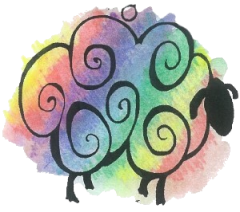If you’ve wondered what “Nm” means with regard to describing yarns, here’s a post for you. We purchase our yarns, when possible, using the “Normal metric” (“Nm”) system. This is one point in our quality-assurance program to ensure that our yarns are all that you expect then to be.
Example
A yarn may be described as “3/15 Nm.”
“3” is the number of plies in that yarn. “15” is an indication of the weight of the yarn.
A denominator of “15” indicates that if you measured 1,000 meters (just under 1,094 yards) of a SINGLE-strand version of that yarn, it would take 15 such skeins to weigh 1 kilogram (2.2 pounds).
NOTE: We’ve often seen these numbers flipped, e.g., “15/3,” most often on British websites. While it may be obvious that the yarn is not 15 ply, sometimes the numbers can be closer, such as 3/5. Simply count your plies to determine which number is plies v. weight.
How to Use this Information
First, the larger the weight number, the finer the base yarn (single ply). That is, a lace-weight yarn will require more yardage – more 1,000-meter, single-ply skeins – to weigh 1 kilogram (around 16). A heavier base-yarn weight – used in DK, for example – will require fewer such skeins to weigh 1 kilogram (about 9).
Second, you can estimate length of yarn given the weight you have on hand. This estimated-weight calculation takes a few steps …
1. A 3/15 yarn is 3-ply and it takes 15 1,000-meter skeins to weigh 1 kilogram.
2. By flipping for the fraction – 15/3 rather than 3/15 – and doing the math – you learn that it would take just 5 1,000-meter skeins of your 3-ply yarn to weigh 1 kilogram (15 divided by 3).
3. Assume that the 3/15 skein of yarn in front of you is a typical 100-gram skein. If 1 kilogram would equal 5,000 meters, then 100 grams would equal 500 meters [(100/1000)*5000]. Convert meters to yards (1 meter = 1.09361 yards), and you learn that your skein is (approximately) just under 547 yards.
4. If you use a kitchen or other small scale to weigh your yarn and you know the Nm, just do Steps 2 (your Nm to calculate your meters/kg) and 3 (your gram weight instead of 100; your meters/kg) to estimate your length on hand.
Second Example
Let’s use a real example. One of our 100% Blue Face Leicester yarns, imported from northern Yorkshire, England, is a British Aran 3/5. The label indicates that it is 160 yards of yarn in a 100-gram skein.
This is 3-ply yarn (3/5). A single strand would take approximately 5,000 meters to weigh 1 kilogram (3/5).
So, how much yardage should you get from a 100-gram (just over 3.5 oz.) skein?
First, divide the denominator (5) by the number of strands (3). 5 divided by 3 = 1.667. This instructs us that 1,667 meters of this 3-ply yarn would weigh 1 kilogram. One-hundred grams should therefore have 167 meters, or just under 183 yards.
Wait, what? The label yardage is only 160. What happened to the other 23 yards?
Ah, well, recall above that we wrote “approximately”? Unfortunately, the industry does not supply decimals in the Nm data. The Nm on this BFL could read anything from 3.0/4.5 to 3.0/5.4, and still read 3/5.
If we use 160 yards on a 3-ply, the denominator comes out to 4.4.
First, let’s observe that the heavier the yarn, the lower the denominator. At some point, one runs out of numbers! There are a few yarns heavier that Aran out there (e.g., “Chunky,” “Bulky,” and others). Since each requires a number lower than our example weight (5), it seems that mills need to round up the denominator at this low end (4.4 rounds to 5) so they don’t have to use the dreaded decimal point and still have numbers left!
Let’s test this theory by calculating our denominator with finer yarns (higher denominator).
Our British BFL Fingering is 4/16 Mn. The label reads 415 yards. At 4-ply and 16,000 meters of one-ply to the kilogram, we would expect that a 100-gram skein would come in at just over 437 yards. 22 yards is covered by the rounding discussed above.
Our British BFL DK 4/9 has a label length of 238 yards. The calculated length is 246 yards. Again, rounding covers it.
We take it a step further.
We monitor the yardage of our skeins on a random and recurring basis. We want to ensure that you get what you expect. Because we’re dealing with rounding implications, small mills, and a natural product, there will always be variation. The length indicated on our label is the lowest we’ve ever reasonably encountered, ensuring that you are never left short.
Enjoy knitting!

